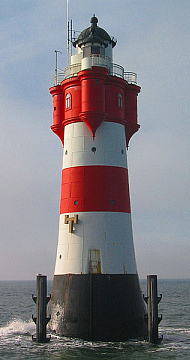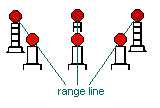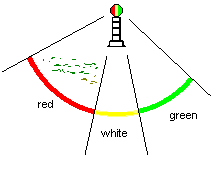Fixed Lights
Lights vary from tall, high intensity coastal lights to battery powered lanterns on
single piles. Highly visible and accurately charted, fixed lights provide navigators
with an excellent source for bearings during the night.To aid in identification during
the day, the building structures of lighthouses are often distinctively colored.
Today, with a few exceptions, all major lights are operated automatically.
Lights and Lighthouses
 |
Lighthouses are placed where they will be of best use: on prominent
headlands, at harbor and port entrances, on isolated dangers or at other
points where mariners can best use them to fix their position. The lighthouse's
principal purpose is to support a light at a considerable height above
the water, thereby increasing its geographical range.
major light is a high-intensity light exhibited
from a fixed structure or a marine site. Major lights include primary seacoast
lights and secondary lights. Primary seacoast lights are those major lights
established for making landfall from sea and coast-wise passages from headland
to headland. Secondary lights are those major lights established at harbor
entrances and other locations where high visibility and reliability are
required.
A minor light usually displays a light of low to moderate intensity.
Minor lights are established in harbors, along channels, rivers and in
isolated locations. They usually have numbering, coloring, light and sound
characteristics that are part of the lateral system of buoyage.
|
Light structures' appearances vary. Lights in low areas usually are
supported by tall towers. Conversely, light structures on high cliffs may
be relatively short. However its support tower is constructed, almost all
lights are similarly generated, focused, colored and characterized.
Some major lights use modern rotating or flashing lights, but many older
lights use Fresnel lenses. These lenses consist of intricately patterned
pieces of glass in a heavy brass framework. Modern Fresnel-type lenses
are cast from high-grade plastic; they are much smaller and lighter than
their glass counterparts.
Description of Lights in the Nautical Chart
The nautical charts summarize the most important features of lighthouses
in the following form:
|
Warnemünde
Fl(3+1)W 24s 24m 20M
Horn Mo (WN) 30s
|
|
The first line is the name of the light.
The second line contains the phase characteristic, color, period,
height of the light (not the building) in meter and the range of
the light in nautical miles respectively.
The third line may contain information about the characteristics
of the fog signal. |
Lights with different color sectors may have the following chart entry:
|
Fehmarnsund-Brücke
Oc. WRG 4s 23m 8-5M
|
|
The letters WRG stand for the colors of the sectors and the range
is given for the white (longest range) and the green sector (shortest range).
The range of the red sector will be between the ranges of the white
and green sectors. |
Detailed descriptions of lights and lighthouses
are obtained from the "List of Lights"
published by e.g. the national lighthouse authorities.
A complete description of the abbreviations used in the nautical
charts can be found in the international "Chart No. 1, Symbols,
Abbreviations, Terms used on Charts" released by the
International
Hydrographic Organization (IHO), Monaco.
Leading Lights

Leading lights or range lights, consist of a pair of lights located such that they
indicate a specific line of position - called "range line" - when they
are observed "in line". Seen from seaward, the higher rear light
is placed behind the lower front light.
When the navigator sees the lights vertically in line, he is proceeding
on the range line. If the front light appears left of the rear light, the
observer is to the right of the range line. If the front appears to the
right of the rear, the observer is left of the range line.
Leading lights are often used to mark the center of navigable channels.
In this case a vessel returning from seaward will keep the front light
slightly to the left of the rear light while navigating on the right side
of the channel.
Leading lights are sometimes equipped with intensity lights for daylight
use. They are effective for long channels in hazy conditions when dayboards
might not be visible.
Range lights are usually red, green or white. They display phase characteristics
differentiating them from surrounding lights.
Sector Lights
 |
Sector lights help to approach a harbor or coastline
while navigating in a coastal channel in shoal waters or between isolated
hazards.
A sector light has precisely oriented colored sectors. Such lights
show different colors when observed from different bearings. This allows
the mariner to approach the light from a hazard-free direction.
The white sector normally indicates the "save" range
of the approaching channel.
The red sector normally indicates the "danger" sector marking
regions of shoal water or navigation hazards. A green sector would indicate
that the vessel is off the center line of the channel in the direction
of deep water. But the red and green sectors may also indicate the vessel
is on the port or starbord side of the safe channel. The actual
situation must be obtained from a nautical chart.
|
Cross-Mark Lights
These lights are used in combination with range lights or direction lights.
They define turning points or areas in which the navigator has to change
course to another light to continue the harbor or river approach. This
lights may be used in narrow and winding navigation channels.
The "active" red sector is usually "announced" by a white sector.
Harbor Lights
Harbor light will indicate the save entrance of an harbor area. They usually
consist of a red and green light. Sometimes only one light is available.
Harbor lights are often hard to identify against the background of bright
city lights such as street lights, traffic lights and flashing neon lights.
On approaching the harbor, the approximate position of the harbor lights
should be estimated from the chart and pilot information to simplify and
certify the correct identification of the lights on the spot.
Buoyant Beacons
A buoyant beacon provides nearly the positional accuracy of a light in
a place where a buoy would normally be used. The buoyant beacon consists
of a heavy sinker to which a pipe structure is tightly moored. A buoyance
chamber near the surface supports the pipe. The light, radar reflector
and other devices are located a"top" the pipe above the surface of the water.
The pipe with its buoyance chamber tends to remain upright even in severe
weather and heavy currents, providing a smaller watch circle than a buoy.
The buoyant beacon is most useful along narrow ship channels in relative
sheltered waters.
|


